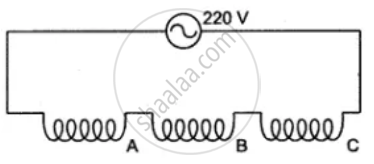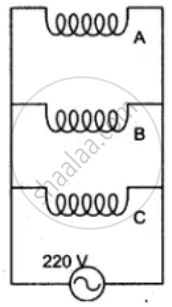Advertisements
Advertisements
प्रश्न
The diagram shows two ways of connecting three lamps P, Q and R to A.C. supply of 220 V.


उत्तर
The arrangement is shown in the figure (i) is a series arrangement. The arrangement in figure (ii) is the parallel arrangement.
We prefer a parallel arrangement. The reasons are:
(i) In series arrangement, if one of the bulbs is fused, the other bulbs also cease to glow. But in a parallel arrangement, if one bulb fuses, the other bulbs continue to glow.
(ii) In the series arrangement, while one bulb glows if the other bulb is switched on, the resistance of the circuit increases, and hence the bulbs glow less bright. But in a parallel arrangement, each bulb glows at the same voltage, therefore the glow of a bulb is unaffected if another bulb is switched on.
संबंधित प्रश्न
What is the current in a circuit if the charge passing each point is 20 C in 40 s?
Which instrument is used to measure electric current? How should it be connected in a circuit?
A flash of lighting carries 10 C of charge which flows for 0.01 s. What is the current? If the voltage is 10 MV, what is the energy?
A car headlight bulb working on a 12 V car battery draws a current of 0.5 A. The resistance of the light bulb is:
(a) 0.5 Ω
(b) 6 Ω
(c) 12 Ω
(d) 24 Ω
Tell the odd one out. Give a proper explanation.
How should the electric lamps in a building be connected?
In current electricity, a positive charge refers to ______.
The flow of electric charge per unit time is called potential difference.
What is the rate at which charges flow past a point on a circuit?
